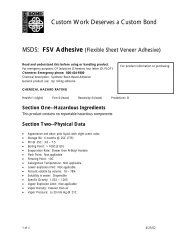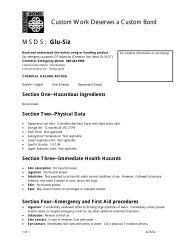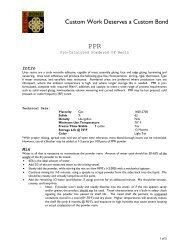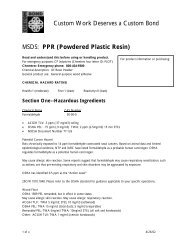CB Melamine MSDS - Veneer Systems, Inc.
CB Melamine MSDS - Veneer Systems, Inc.
CB Melamine MSDS - Veneer Systems, Inc.
You also want an ePaper? Increase the reach of your titles
YUMPU automatically turns print PDFs into web optimized ePapers that Google loves.
Custom Work Deserves a Custom Bond<br />
<strong>MSDS</strong>: <strong>Melamine</strong><br />
Read and understand this before using or handling product.<br />
For emergency purposes: CP Industries (Chemtrec four letter ID: PLOT)<br />
Chemtrec Emergency phone: 800-424-9300<br />
Chemical description: Vinyl/Acrylic Emulsion<br />
General product use: Specialty adhesive<br />
For product information or purchasing:<br />
CHEMICAL HAZARD RATING<br />
Health=1 (slight) Fire=0 (least) Reactivity=0 (least)<br />
Section One--Hazardous Ingredients<br />
None Known<br />
Section Two--Physical Data<br />
• Appearance and odor: White opaque liquid, with slight acetic odor.<br />
• Storage life: 6 months @ 21C (70F)<br />
• PH @ 25C: ~4.75<br />
• Boiling Point: 100C(212F)<br />
• Evaporation Rate: As water,
Custom Work Deserves a Custom Bond<br />
Section Three--Immediate Health Hazards<br />
• Skin absorption: No hazards known.<br />
• Ingestion: No hazards known.<br />
• Inhalation: Not expected to be harmful under normal conditions of use. However, if allowed to become<br />
airborne, may cause irritation of nose, throat and lungs.<br />
• Skin: May cause irritation on prolonged or repeated contact.<br />
• Eyes: May cause irritation on prolonged or repeated contact.<br />
Section Four--Emergency and First Aid procedures<br />
• Ingestion: If accidentally swallowed dilute by drinking large quantities of water. Immediately contact poison<br />
control center or hospital emergency room for any other additional treatment directions.<br />
• Inhalation: Remove to fresh air.<br />
• Skin contact: In case of irritation, flush with water.<br />
• Eye contact: Immediately flush eyes with plenty of water. Call a physician if irritation persists.<br />
Section Five--Fire and Explosion Hazards<br />
Will not burn.<br />
containers cool.<br />
In case of fire use water spray, dry chemical, foam or CO2. Use water to keep fire-exposed<br />
Section Six--Safe Handling and Personal Protection<br />
• Personal protection<br />
Where air contaminants can exceed acceptable criteria, use NIOSH/MSHA approved respiratory<br />
protection equipment. Respirators should be selected based on the form and concentration of contaminants in air<br />
in accordance with OSHA 29 CFR 1910.134 or other applicable standards or guidelines.<br />
If airborne contaminants are generated when the material is heated or handled, sufficient ventilation in<br />
volume and air flow patterns should be provided to keep air contaminant concentration levels below acceptable<br />
criteria.<br />
• Safe Handling<br />
Inhalation: Avoid prolonged or repeated breathing of vapor.<br />
Skin: Avoid prolonged or repeated contact with skin.<br />
Eyes: Avoid prolonged or repeated contact with eyes.<br />
Handle in accordance with good industrial hygiene and safety practices. These practices include avoiding<br />
unnecessary exposure and removal of the material from eyes, skin and clothing. Wash hands thoroughly after<br />
handling.<br />
2 of 4 4/25/02
Custom Work Deserves a Custom Bond<br />
Section Seven--Spill or Leak and Disposal Procedures<br />
• Spill or leak<br />
Large quantities: Enclose with diking material to prevent seepage into natural bodies of water, then<br />
consult Custom-Pak Adhesives.<br />
Small quantities: Soak up with absorbent material and remove to chemical disposal area.<br />
• Disposal<br />
Recover free liquid. Absorb residue and dispose of according to local, state/provincial, and federal<br />
requirements.<br />
Section Eight--Storage<br />
• Keep from freezing.<br />
• Do not store near strong oxidizing chemicals.<br />
• Store in a tightly closed container.<br />
Section Nine--Transportation<br />
Refer to bill of lading for proper DOT description.<br />
Section Ten--Reactivity Data<br />
• Normally stable as defined in NFPA 704-12(4-3.1).<br />
• Hazardous polymerization: Will not occur.<br />
• <strong>Inc</strong>ompatibilities: Oxidizers, acids or bases.<br />
• Decomposition products may include: Oxides of carbon.<br />
Section Eleven--Regulatory and other information<br />
The OSHA Hazard Communication Standard 29 CFR 1910.1200 requires that the information contained on these<br />
sheets be made available to your workers. Instruct your workers to handle this product properly.<br />
3 of 4 4/25/02
Custom Work Deserves a Custom Bond<br />
SARA TITLE III SECTION 313<br />
AND 40 CFR PART 372<br />
TOXIC CHEMICAL NOTIFICATION SHEET<br />
<strong>Melamine</strong><br />
This product contains NO toxic chemical(s) subject to the reporting requirements of Section<br />
313 of Title III of the Superfund Amendments and Reauthorization Act of 1986, and Subpart C-<br />
Supplier Notification Requirement of 40 CFR Part 372.<br />
This Toxic Chemical Notification Sheet must not be detached from the <strong>MSDS</strong>. Any copying and<br />
redistribution of the <strong>MSDS</strong> shall include copying and redistribution of this notification sheet<br />
attached to copies of the <strong>MSDS</strong> subsequently redistributed.<br />
4 of 4 4/25/02












